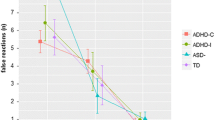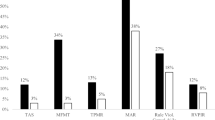Abstract
Recent research on the DSM-IV subtypes of attention-deficit/hyperactivity disorder (ADHD) has demonstrated that the subtypes differ in demographic characteristics, types of functional impairment, and profiles of comorbidity with other childhood disorders. However, little research has tested whether the subtypes differ in underlying neuropsychological deficits. This study compared the neuropsychological profiles of children without ADHD (n = 82) and children who met symptom criteria for DSM-IV Predominantly Inattentive subtype (ADHD-IA; n = 67), Predominantly Hyperactive Impulsive subtype (ADHD-HI; n = 14), and Combined subtype (ADHD-C; n = 33) in the areas of processing speed, vigilance, and inhibition. We hypothesized that children with elevations of inattention symptoms (ADHD-IA and ADHD-C) would be impaired on measures of vigilance and processing speed, whereas children with significant hyperactivity/impulsivity (ADHD-HI and ADHD-C) would be impaired on measures of inhibition. Contrary to prediction, symptoms of inattention best predicted performance on all dependent measures, and ADHD-IA and ADHD-C children had similar profiles of impairment. In contrast, children with ADHD-HI were not significantly impaired on any dependent measures once subclinical symptoms of inattention were controlled. Our results do not support distinct neuropsychological deficits in ADHD-IA and ADHD-C children, and suggest that symptoms of inattention, rather than symptoms of hyperactivity/impulsivity, are associated with neuropsychological impairment.
Similar content being viewed by others
REFERENCES
American Psychiatric Association. (1980). Diagnostic and statistical manual of mental disorders (3rd ed.). Washington, DC: Author.
American Psychiatric Association. (1994). Diagnostic and statistical manual of mental disorders (4th ed.). Washington, DC: Author.
Barkley, R. A. (1997). Behavioral inhibition, sustained attention, and executive functions: Constructing a unifying theory of ADHD. Psychological Bulletin, 121, 65–94.
Barkley, R. A., DuPaul, G. J., & McMurray, M. B. (1990). Comprehensive evaluation of attention deficit disorder with and without hyperactivity as defined by research criteria. Journal of Consulting and Clinical Psychology, 58, 775–789.
Barkley, R. A., & Murphy, K. (1998). Attention-deficit hyperactivity disorder: A clinical workbook (2nd ed.). New York: Guilford Press.
Berkson, J. (1946). Limitations of the application of fourfold table analysis to hospital data. Biometrics Bulletin, 2, 47–53.
Borenstein, M., & Cohen, J. (1988). Statistical power analyses: A computer program. Hillsdale, NJ: Erlbaum.
Carlson, C. L. (1986). Attention deficit disorder without hyperactivity: A review of preliminary experimental evidence. In B. B. Lahey & A. E. Kazdin (Eds.), Advances in clinical child psychology (pp. 153–175). New York: Plenum.
Carlson, C. L., & Mann, M. (under review). Sluggish cognitive tempo predicts a different pattern of impairment in the Attention Deficit Hyperactivity Disorder, Predominantly Inattentive Type.
DeFries, J. C. (1985). Colorado reading project. In D. Gray & J. Kavanaugh J. (Eds.), Biobehavioral measures of dyslexia. Parkton, MD: York Press.
DeFries, J. C., Filipek, P. A., Fulker, D. F., Olson, R. K., Pennington, B. F., Smith, S. D., & Wise, B.W. (1997). Colorado Learning Disabilities Research Center. Learning Disabilities, 8, 7–19.
Dunn, L. M., & Markwardt, F. C. (1970). Examiner's manual: Peabody Individual Achievement Test. Circle Pines, MN: American Guidance Service.
DuPaul, G. J., Anastopoulos, A. D., McGoey, K. E., Power, T. J., Reid, R., & Ikeda, M. J. (1997). Teacher ratings of attention deficit hyperactivity disorder symptoms: Factor structure and normative data. Psychological Assessment, 9, 436–444.
Eiraldi, R. B., Power, T. J., & Nezu, C. M. (1997). Patterns of comorbidity associated with subtypes of Attention-Deficit Hyperactivity Disorder among 6–to 12–year-old children. Journal of the American Academy of Child and Adolescent Psychiatry, 36, 503–514.
Faraone, S., Biederman, J., Weber,W., & Russell, R. (1998). Psychiatric, neuropsychological, and psychosocial features of DSM-IV subtypes of attention-deficit/hyperactivity disorder: Results from a clinically referred sample. Journal of the American Academy of Child and Adolescent Psychiatry, 37, 185–193.
Gordon, M., & Mettelman, B. B. (1988). The assessment of attention: I. Standardization and reliability of a behavior-based measure. Journal of Clinical Psychology, 44, 682–690.
Hart, E. L., Lahey, B. B., Loeber, R., Applegate, B., Green, S. M., & Frick, P. J. (1995). Developmental change in attention-deficit hyperactivity disorder in boys:Afour-year longitudinal study. Journal of Abnormal Child Psychology, 23, 729–749.
Houghton, S., Douglas, G., West, J., Whiting, K., Wall, M., Langsford, S., Powell, L., & Carroll, A. (1999). Differential patterns of executive function in children with attention-deficit hyperactivity disorder according to gender and subtype. Journal of Child Neurology, 14, 801–805.
Hynd, G. W., Nieves, N., Conner, R., Stone, P., Town, P., Becker, M. G., Lahey, B. B., & Lorys, A. R. (1989). Speed of neurocognitive processing in children with attention deficit disorder with and without hyperactivity. Journal of Learning Disabilities, 22, 573–579.
Klorman, R., Hazel-Fernandez, L. A., Shaywitz, S. E., Fletcher, J. M., Marchione, K. E., Holahan, J. M., Stuebing, K. K., & Shaywitz, B. A. (1999). Executive functioning deficits in attention-deficit/ hyperactivity disorder are independent of oppositional defiant or reading disorder. Journal of the American Academy of Child and Adolescent Psychiatry, 38, 1148–1155.
Lahey, B. B., Applegate, B., McBurnett, K., Biederman, J., Greenhill, L., Hynd, G. W., Barkley, R. A., Newcornn, J., Jensen, P., Richters, J., Garfinkel, B., Kerdy, K. L., Rick, P. J., Ollendick, T., Perez, D., Hart, E. L., Waldman, I., & Shaffer, D. (1994). DSM-IV field trials for Attention Deficit Hyperactivity Disorder in children and adolescents. American Journal of Psychiatry, 151, 673–685.
Lahey, B. B., Pelham, W. E., Schaughency, E. A., Atkins, M. S., Murphy, H. A., Hynd, G. W., Russo, M., Hartdagen, S., & Lorys-Vernon, A. (1988). Dimensions and types of attention deficit disorder. Journal of the American Academy of Child and Adolescent Psychiatry, 27, 330–335.
Lahey, B. B., Pelham, W. E., Stein, M. A., Loney, J., Trapani, C., Nugent, K., Kipp, H., Schmidt, E., Lee, S., Cale, M., Gold, E., Hartung, C. M., Willcutt, E. G., & Baumann, B. (1998). Validity of DSM-IV Attention-deficit/Hyperactivity Disorder for young children. Journal of the American Academy of Child and Adolescent Psychiatry, 37, 695–702.
Logan, G. D. (1994). On the ability to inhibit thought and action: A user's guide to the stop signal paradigm. In D. Dagenbach and T. H. Carr (Eds.), Inhibitory processes in attention, memory, and language (pp. 189–239). San Diego: Academic Press.
Logan, G. D., Cowan, W. B., & Davis, K. A. (1984). On the ability to inhibit simple and choice reaction time responses: A model and a method. Journal of Experimental Psychology: Human Perception and Performance, 10, 276–291.
Logan, G. D., Schachar, R. J., & Tannock, R. (1997). Impulsivity and inhibitory control. Psychological Science, 8, 60–64.
Maedgen, J. W., & Carlson, C. L. (2000). Social functioning and emotional regulation in the attention deficit hyperactivity disorder subtypes. Journal of Clinical Child Psychology, 29, 30–42.
McBurnett, K. (1997). Attention Deficit Hyperactivity Disorder: A review of diagnostic issues. In T. A. Widiger, A. J. Frances, H. Pincus, R. Ross, M. First, & W. Davis (Eds.), DSM sourcebook (pp. 111–143). Washington DC: American Psychiatric Association.
McBurnett, K., Pfiffner, L. J., & Frick, P. J. (2001). Symptom Properties as a Function of ADHD Type: An Argument for Continued Study of Sluggish Cognitive Tempo. Journal of Abnormal Child Psychology, 29, 207–213.
McBurnett, K., Pfiffner, L. J., Willcutt, E., Tamm, L., Lerner, M., Ottolini, Y. L., & Furman, M. B. (1999). Experimental cross-validation of the DSM-IV types of Attention-Deficit/Hyperactivity Disorder. Journal of the American Academy of Child and Adolescent Psychiatry, 38, 17–24.
Milich, R., Balentine, A. C., & Lynam, D. R. (in press).ADHD-combined type and ADHD predominately inattentive type are distinct and unrelated disorders. Clinical Psychology: Science and Practice.
Nigg, J. T. (1999). The ADHD response-inhibition deficit as measured by the stop task: Replication with DSM-IV combined type, extension, and qualification. Journal of Abnormal Child Psychology, 27, 393–402.
Nigg, J. T., Blaskey, L., Huang-Pollack, C., & Rappley, M. D. (under review). Neuropsychological Executive Functions and ADHD DSM-IV Subtypes.
Nigg, J. T., Hinshaw, S. P., Carte, E. T., & Treuting, J. J. (1998). Neuropsychological correlates of childhood Attention-Deficit/Hyperactivity Disorder: Explainable by comorbid disruptive behavior or reading problems? Journal of Abnormal Psychology, 107, 468–480.
Oosterlaan, J., & Sergeant, J. A. (1998). Response inhibition in ADHD, CD, comorbid ADHD C CD, anxious and normal children: A meta-analysis of studies with the stop task. Journal of Child Psychology and Psychiatry, 39, 411–426.
Pennington, B. F., Grossier, D., & Welsh, M. C. (1993). Contrasting cognitive deficits in Attention Deficit Hyperactivity Disorder versus Reading Disability. Developmental Psychology, 29, 511–523.
Pennington, B. F., & Ozonoff, S. (1996). Executive functions and developmental psychopathology. Journal of Child Psychology and Psychiatry, 37, 51–87.
Piacentini, J. C., Cohen, P., & Cohen, J. (1992). Combining discrepant information from multiple sources: Are complex algorithms better than simple ones? Journal of Abnormal Child Psychology, 20, 51–62.
Plomin, R., DeFries, J. C., McClearn, G. E., & Rutter, M. (1997). Behavioral genetics (3rd ed.). New York: Freeman.
Reitan, R., & Wolfson, D. (1985). The Halstead-Reitan Neuropsychological Test Battery: Theory and clinical interpretation. Tucson: Neuropsychology Press.
Rosvold, H. E., Mirsky, A. F., Sarason, I., Bransome, E. D., & Beck, L. H. (1956). A continuous performance test of brain damage. Journal of Consulting Psychology, 20, 343–350.
Sandberg, S. (Ed.). (1996). Hyperactivity disorders of childhood. Cambridge monographs on child and adolescent psychiatry 2. New York: Cambridge University Press.
Schaughency, E. A., Lahey, B. B., Hynd, G. W., Stone, P. A., & Piacentini, J. C. (1989). Neuropsychological test performance and the attention deficit disorders: Clinical utility of the Luria-Nebraska Neuropsychological Battery-Children's Revision. Journal of Consulting and Clinical Psychology, 57, 112–116.
Sergeant, J. A., & Scholten, C. A. (1985). On data limitations in hyperactivity. Journal of Child Psychology and Psychiatry and Allied Disciplines, 26, 111–124.
Wechsler, D. (1974). Examiner's manual: Wechsler Intelligence Scale for Children-Rev. New York: The Psychological Corporation.
Wechsler, D. (1981). Manual for the Wechsler Adult Intelligence Scale-Rev. San Antonio: The Psychological Corporation.
Wechsler, D. (1991). Manual for the Wechsler Intelligence Scale for Children (3rd ed.). San Antonio, TX: The Psychological Corporation.
Werry, J. S., Elkind, G. S., & Reeves, J. C. (1987). Attention deficit, conduct, oppositional, and anxiety disorders in children: III. Laboratory differences. Journal of Abnormal Child Psychology, 15, 409–428.
Willcutt, E. G., Pennington, B. F., Chhabildas, N. A., Friedman, M. C., & Alexander, J. A. (1999). Psychiatric comorbidity associated with DSM-IV ADHD in a nonreferred sample of twins. Journal of the American Academy of Child and Adolescent Psychiatry, 38, 1355–1362.
Willcutt, E. G., Pennington, B. F., & DeFries, J. C. (2000). Etiology of inattention and hyperactivity/impulsivity in a community sample of twins with learning difficulties. Journal of Abnormal Child Psychology, 28, 149–159.
Author information
Authors and Affiliations
Rights and permissions
About this article
Cite this article
Chhabildas, N., Pennington, B.F. & Willcutt, E.G. A Comparison of the Neuropsychological Profiles of the DSM-IV Subtypes of ADHD. J Abnorm Child Psychol 29, 529–540 (2001). https://doi.org/10.1023/A:1012281226028
Issue Date:
DOI: https://doi.org/10.1023/A:1012281226028




